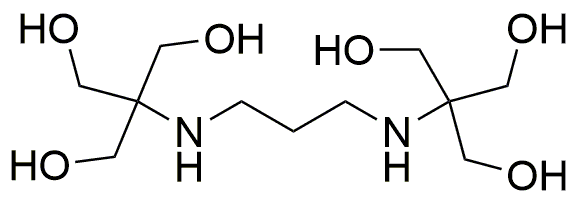1,3-Bis(tris(hydroxymethyl)methylamino)propane is widely utilized in research focused on:
- Biotechnology: This compound serves as a buffering agent in biological systems, helping to maintain pH stability in cell cultures and enzyme reactions, which is crucial for accurate experimental results.
- Pharmaceutical Development: It is used in drug formulation to enhance the solubility and stability of active pharmaceutical ingredients, making it easier to develop effective medications.
- Analytical Chemistry: The compound acts as a stabilizing agent in various analytical techniques, improving the reliability of results in methods such as chromatography and spectrometry.
- Cosmetic Industry: Its properties make it an excellent ingredient in skincare formulations, providing hydration and stability to products, which enhances their performance and shelf life.
- Environmental Science: It is applied in the treatment of wastewater, where it helps in the removal of heavy metals and other contaminants, contributing to cleaner water systems.
Informations générales
Propriétés
Sécurité et réglementation
Applications
1,3-Bis(tris(hydroxymethyl)methylamino)propane is widely utilized in research focused on:
- Biotechnology: This compound serves as a buffering agent in biological systems, helping to maintain pH stability in cell cultures and enzyme reactions, which is crucial for accurate experimental results.
- Pharmaceutical Development: It is used in drug formulation to enhance the solubility and stability of active pharmaceutical ingredients, making it easier to develop effective medications.
- Analytical Chemistry: The compound acts as a stabilizing agent in various analytical techniques, improving the reliability of results in methods such as chromatography and spectrometry.
- Cosmetic Industry: Its properties make it an excellent ingredient in skincare formulations, providing hydration and stability to products, which enhances their performance and shelf life.
- Environmental Science: It is applied in the treatment of wastewater, where it helps in the removal of heavy metals and other contaminants, contributing to cleaner water systems.
Documents
Fiches de données de sécurité (FDS)
La FDS fournit des informations de sécurité complètes sur la manipulation, le stockage et l’élimination du produit.
Spécifications du produit (PS)
Le PS fournit une description complète des propriétés du produit, notamment sa composition chimique, son état physique, sa pureté et les exigences de stockage. Il détaille également les plages de qualité acceptables et les applications prévues du produit.
Certificats d'analyse (COA)
Recherchez des certificats d'analyse (COA) en saisissant le numéro de lot du produit. Les numéros de lot et de lot se trouvent sur l'étiquette d'un produit, après les mots « Lot » ou « Lot de fabrication ».
Numéro de catalogue
Numéro de lot/série
Certificats d'origine (COO)
Ce certificat d'exploitation confirme le pays dans lequel le produit a été fabriqué, et détaille également les matériaux et composants utilisés et s'il est issu de sources naturelles, synthétiques ou autres sources spécifiques. Ce certificat peut être requis pour les douanes, le commerce et la conformité réglementaire.
Numéro de catalogue
Numéro de lot/série
Fiches de données de sécurité (FDS)
La FDS fournit des informations de sécurité complètes sur la manipulation, le stockage et l’élimination du produit.
DownloadSpécifications du produit (PS)
Le PS fournit une description complète des propriétés du produit, notamment sa composition chimique, son état physique, sa pureté et les exigences de stockage. Il détaille également les plages de qualité acceptables et les applications prévues du produit.
DownloadCertificats d'analyse (COA)
Recherchez des certificats d'analyse (COA) en saisissant le numéro de lot du produit. Les numéros de lot et de lot se trouvent sur l'étiquette d'un produit, après les mots « Lot » ou « Lot de fabrication ».
Numéro de catalogue
Numéro de lot/série
Certificats d'origine (COO)
Ce certificat d'exploitation confirme le pays dans lequel le produit a été fabriqué, et détaille également les matériaux et composants utilisés et s'il est issu de sources naturelles, synthétiques ou autres sources spécifiques. Ce certificat peut être requis pour les douanes, le commerce et la conformité réglementaire.

